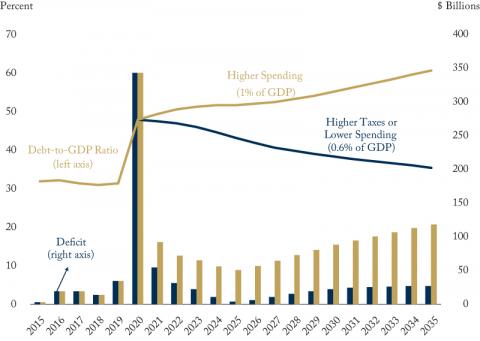From: Alexandre Laurin
To: Chrystia Freeland, Minister of Finance
Date: November 26, 2020
Re: Ottawa Needs a Clear Debt Reduction Target in Monday’s Fiscal Update
Ottawa’s September Speech from the Throne signalled the government’s intention to add tens of billions of dollars to ongoing federal spending. This new permanent, unfunded spending would likely push the federal debt-to-GDP ratio in an upward trajectory for the foreseeable future. In addition, Ottawa is facing pressures from provinces for a substantial increase in health transfers. Fiscal sustainability will require discipline. The federal government needs a clear debt target anchoring its fiscal policy, and this target needs to aim for a declining debt-to-GDP ratio.
Aiming to keep the debt-to-GDP ratio roughly constant is not a useful guide to fiscal policy. Not having a clear debt-level target is the equivalent of having the anchor suspended a few inches above the seabed. The anchor may slow the ship, but it won’t prevent it from drifting into dangerous waters. Planning for a stable debt ratio will inevitably leave the ratio at the mercy of economic slowdowns, drifting upwards every time the economy hits the bottom of the business cycle.
Another problem is that the size of the deficit stabilizing the debt ratio is a function of the debt level itself. Take for example the economy growing at 4 percent and the interest rate at 2 percent. Keeping the debt stable at 60 percent of GDP, for example, allows for a perpetual annual primary deficit of 1.2 percent (60 x [4 – 2]) of GDP, while stabilizing the debt at 30 percent of GDP would allow for a deficit “only” half of that size.
There is a short-term political incentive for the government to “stabilize” the debt ratio at a level as high as possible, because the higher the debt, the higher the ratio-stabilizing deficit (and the permanent size of the expenditure budget) in a growing economy. Clearly, if Ottawa is aiming for a stable debt-to-GDP ratio once the crisis recedes, it will want to ratchet up the debt as much as possible before the COVID clouds clear.
But the size of the debt itself matters. The long-term cost of a high debt ratio is a future government’s problem. Ottawa’s huge post-war debt burden had been reduced to roughly 20 percent of GDP by the early 1970s. At the time, the interest rate on the debt was much lower than GDP growth, and had been on average for an extended period. Large deficits to finance social programs looked cheap under Pierre Trudeau’s governments. That is, until the 1980s, when the growth/interest rate differential shifted, and the debt-to-GDP ratio skyrocketed. We all remember how the story ends: first with the Mulroney then the Chrétien governments having to raise taxes and cut spending by multiple points of GDP simply to bring the debt burden under control again.
When interest rates rise, the higher the debt, the more painful the effort needed to keep the debt ratio from growing. High-debt countries experience larger increases in interest rates in response to unexpected change in economic conditions and volatility. In addition, public debt carries economic costs beyond the interest charges because of lost future investment crowded out by higher taxes and/or interest rates.
Ottawa must restore its fiscal capacity to manage future shocks. Very low interest rates now, and expected in the next few years, should be used to ease a necessary shrinking of the deficit to sufficiently prepare for a probable gradual interest rate increase. Ottawa should aim to slowly reduce the debt-to-GDP ratio by roughly one percentage point a year for the next 15 years post-crisis. This would require higher taxes, lower spending, or a combination of both amounting to roughly 0.6 percent of GDP (see Figure).
The less prudent approach would be to surf on currently low interest rates by permanently increasing spending. The combination of strong rebound growth and very low interest rates may make this option appear manageable in the near term, resulting in a relatively stable debt-to-GDP. But in the longer run, it would leave Ottawa vulnerable to gradually rising interest rates, just as it was in the 1980s, with projected annually recurrent deficits exceeding $100 billion in just 10 years’ time (see Figure).
Interest rates are likely to rise eventually. And when they do, the higher the deficit and debt level, the more painful the burden for future generations. We must avoid repeating the mistakes of the past. Intergenerational equity requires that we set a prudent fiscal course that will give our descendants the same flexibility to deal with a future crisis, and the ability to enjoy our level of public services.
Alexandre Laurin is Director of Research at the C.D. Howe Institute.
To send a comment or leave feedback, email us at blog@cdhowe.org.
The views expressed here are those of the author. The C.D. Howe Institute does not take corporate positions on policy matters.
Future Fiscal Trajectories Under Two Different Scenarios
Notes: The effective interest rate on federal debt is assumed to continue its decline until it reaches 1.44 percent in 2024 (2.5 percent below GDP growth), then it gradually increases until it becomes 0.5 percent below GDP growth in 2035. The higher spending scenario (1 percent of GDP) represents roughly $24 billion in 2021 of new permanent spending. The lower spending scenario (0.6 percent of GDP) represents roughly of $14 billion in 2021 of permanent tax increase or spending restraint.
Source: Author’s calculations based on data from the November 2020 Fiscal Sustainability Report of the Parliamentary Budget Officer.






